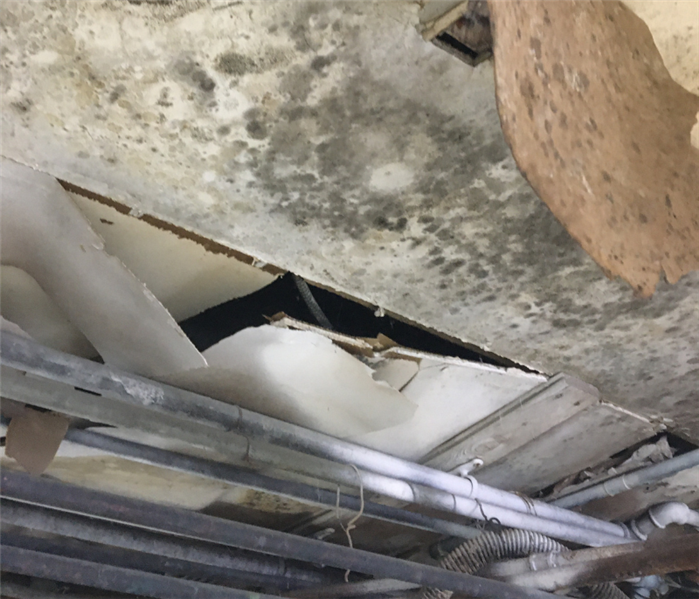Attic Mold Removal in Lambertville, NJ
6/7/2022 (Permalink)
 When you find mold in your attic, SERVPRO of Greater Hunterdon County is here to provide a free remediation estimate!
When you find mold in your attic, SERVPRO of Greater Hunterdon County is here to provide a free remediation estimate!
Mold in Your Attic? Get A Free Remediation Estimate Today!
Did you know that your attic is one of the most common places to find mold? Attics typically create the perfect environment for mold to grow, but since homeowners don't frequently use their attics, mold issues usually aren't caught until they've become severe or discovered in a home inspection.
When you find mold in your attic space, SERVPRO of Greater Hunterdon County is here to provide a free inspection and estimate for attic mold removal near Lambertville!
Call Our Office To Schedule A Free Estimate - 908-788-1776
Professional Attic Mold Remediation in Lambertville, NJ
15+ Years Experience
IICRC Certified
Full Cleaning & Sanitizing
Odor Removal
Free Mold Inspections
Free Mold Removal Estimates
When you need attic mold removal services, you want a company you can trust to get the job done right, and make sure that mold doesn't spread to other areas of your home.
With over 15 years of experience in attic mold removal near Lambertville and the surrounding areas, SERVPRO of Greater Hunterdon County is ready to handle any size mold problem. Our IICRC Certified mold removal specialists understand how mold forms, grows, spreads, as well as how to properly remediate the issue to prevent future mold growth.
When you call SERVPRO of Greater Hunterdon County for attic mold removal in Lambertville, NJ, our goal is to make your mold issue "Like it never even happened."
Common Causes of Attic Mold Growth
Mold only needs three things to grow and spread: moisture, organic matter (building materials), and warm enough temperatures. There are several things that create this perfect environment for attic mold growth:
- Roof leaks
- Improper ventilation
- Lack of proper insulation
- Leaks in HVAC ductwork
- Exhaust fans letting go into attic
- High levels of humidity
Attic Mold Remediation Process
Your local SERVPRO in Lambertville, NJ will create a unique plan for each attic mold remediation in Lambertville, NJ, but the general process remains the same.
1. Inspection and Mold Damage Assessment
Our Project Manager carefully inspects your property for visible signs of mold to create a plan for complete attic mold removal in Lambertville, NJ. They will also take moisture readings to determine if a moisture problem needs to be addressed to prevent future mold growth. SERVPRO of Greater Hunterdon County does not provide mold testing services.
2. Mold Containment
Our team uses various mold containment methods to prevent the spread of mold spores throughout your property during the remediation process. This step is usually completed with physical barriers and negative air pressure to isolate the contaminated area. We'll also turn off the property's fans and heating and cooling systems.
3. Air Filtration
Our professionals at SERVPRO of Greater Hunterdon County use specialized filtration equipment to remove microscopic mold spores from the air. Our team also uses powerful air scrubbers and HEPA vacuums to prevent the spread of mold or lingering spores after the remediation process is complete.
4. Removing Mold and Mold-Infested Materials
The mold remediation process can vary depending on the amount of mold growth and types of surfaces affected. Some mold-infested porous materials, like drywall and carpeting, may need to be disposed of to remediate heavy mold growth.
5. Cleaning Contents and Sanitizing
Our team uses a variety of techniques to clean and disinfect your furniture, clothing, and other restorable items affected by the mold. We also use antifungal and antimicrobial treatments to eliminate mold colonies and help prevent new ones from forming. Our crew can also remove odors and provide deodorization using fogging equipment.
6. Restoration
The final step in your attic mold remediation in Lambertville, NJ is getting your home or business back to normal. Since it's often necessary to remove porous building materials like subfloors, drywall, and carpet during the remediation process, our in-house construction division takes over to fully restore your property. The restoration step may involve minor repairs, such as replacing a few drywall panels, or could include major reconstruction of various areas in your property.


 24/7 Emergency Service
24/7 Emergency Service